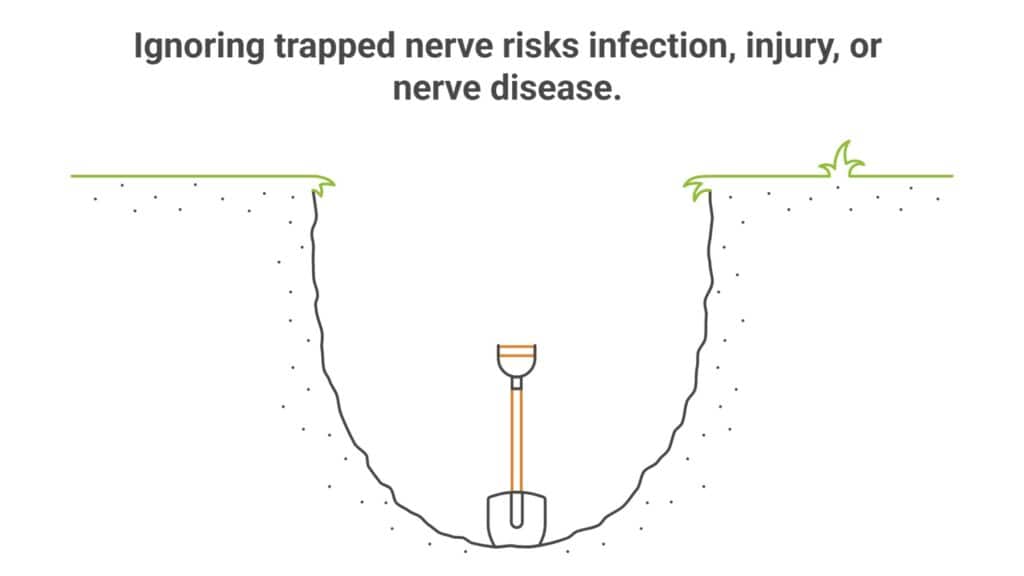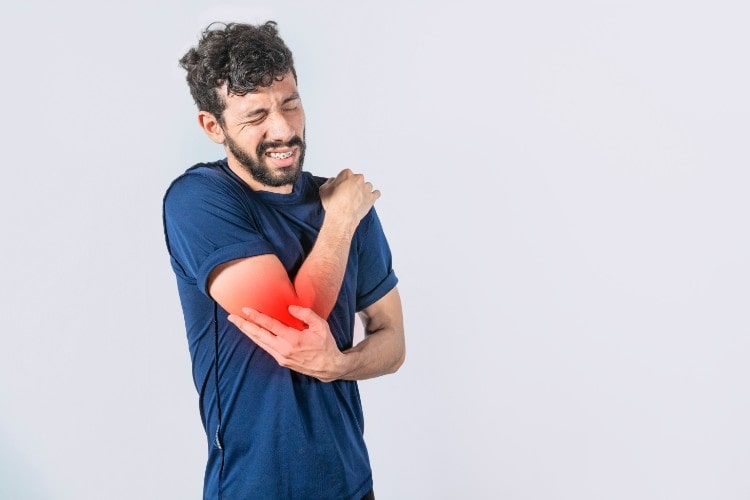Table of Contents
Main Takeaways
- Don’t ignore persistent symptoms — get assessed early: If your nerve pain lasts more than a week, disrupts daily life, or causes worry, consult a physiotherapist to rule out serious conditions and start treatment.
- Accurate diagnosis is vital for effective recovery: A physiotherapist can confirm whether your symptoms stem from a trapped nerve or another issue and tailor a safe, targeted treatment plan accordingly.
- Targeted treatments vary by nerve location: Neck, back, elbow, or wrist issues each require specific stretches, manual therapy, and posture correction to relieve nerve compression and restore mobility.
- Rest and guided exercises work best together: Resting reduces strain on the nerve, while physiotherapist-recommended exercises restore function without risking further irritation or injury.
- Over-the-counter relief can support healing: Painkillers like ibuprofen help manage inflammation, but professional guidance ensures the underlying issue is properly addressed and doesn’t become chronic.
The feeling of a trapped nerve is uncomfortable, to say the least. But you don’t have to just put up with the pain and discomfort. Getting rid of a trapped nerve is something we can help you with at our London physiotherapy clinics – and in this article!
This guide will explore effective strategies, including exercises, posture adjustments, and other treatments, to help you alleviate the pain and get back to your routine. Let’s dive into the steps you can take to get rid of a trapped nerve.
Understanding Trapped Nerves

A trapped nerve, which you might also know as a pinched nerve, happens when surrounding tissues such as bones, cartilage, muscles, or tendons put too much pressure on a nerve. This pressure disrupts the nerve’s function, leading to pain, tingling, or numbness in the affected area.
But what does that actually mean?
At an anatomical level, nerves are bundles of fibres that carry signals between your brain and other parts of your body. They are found almost everywhere in your body. When a nerve is compressed, the signals get interrupted, causing symptoms that might include:
- Sharp or burning pain
- Tingling sensations
- Numbness
- Muscle weakness
You might have just a few of these symptoms or all of them. They can range in intensity too. So, if you’re unsure if you have a trapped nerve or another similar condition, don’t hesitate to book an assessment with a physiotherapist to find out.
Do You Need a Diagnosis?

For many people, it is tempting to just ignore a trapped nerve. With rest and perhaps a massage from your partner, there’s a chance that it could resolve by itself. But that’s a gamble.
The pain of a trapped nerve could also be a sign of infection, injury or even progressive nerve disease. Just like a trapped nerve, these conditions can suddenly emerge without warning.
So, when should you see a physiotherapist and when should you just wait it out? Here’s our advice:
- If the severity of the pain is limiting your life and ability to carry out daily tasks, book an appointment.
- If the pain lasts for longer than a week, even if it’s low to moderate, book an appointment.
- If you’ve experienced this trapped nerve or nerve pain before (reoccurring), book an appointment.
- If you’re losing sleep or just worried about your symptoms, book an appointment so we can give you peace of mind!
An appointment with a physiotherapist is a chance to get an assessment and rule out other conditions. You’ll also get a treatment plan that effectively resolves your trapped nerve, so you’ll be in complete control of your recovery.
Book an assessment at One Body London today.
Physiotherapist Advice

As licensed and registered physiotherapists, we have seen many trapped nerves and other nerve-related conditions in our state-of-the art London clinics. The most common trapped nerves that we regularly see are located in the:
- Neck (cervical radiculopathy)
- Lower back (lumbar radiculopathy)
- Wrist (carpal tunnel syndrome)
- Elbow (cubital tunnel syndrome)
Most trapped nerves respond well to manual therapy to massage and manipulate the area.
Trapped Nerve in Neck or Shoulder
A trapped nerve in the neck or shoulder can be particularly limiting, reducing your ability to turn your head or lift your arms. To treat this trapped nerve, we need to first treat the pain with painkillers or heat packs – this will relax the muscles enough for treatment.
Next, we’ll massage the area and take you through exercises. Shoulder rolls, neck tucks and head turns are all very simple exercises that we can work on to mobilise the area and release the trapped nerve.
Trapped Nerve in Back
A trapped nerve in your back can present with shooting pains that travel down the buttocks and leg, especially if the trapped nerve is in your lower spine. These symptoms are very similar to sciatica, so getting an assessment for a diagnosis is important.
We use massage to treat your back and gentle stretches involving the legs and back to decompress the spine.
Trapped Nerve in Elbow or Wrist

For a trapped nerve in the elbow or wrist, we’ll focus on gentle stretches that involve flexing and extending the wrist. Similar to the exercises we recommend for tennis elbow, these stretches target the wrist, forearm and elbow to release your trapped nerve.
Before you try to do any of these exercises at home, it’s important to see a physiotherapist. One of our expert musculoskeletal physios can show you how to correctly perform these exercises. Importantly, they’ll also explain when to rest and when to exercise – finding the right balance will boost your recovery while overdoing it can have the opposite effect!
For personal advice, explore our London physiotherapy services today.
Trapped Nerve Treatment FAQs
How do you release a trapped nerve?
Rest, physiotherapy and exercises are the most effective methods to reduce the pressure on your nerve, thus releasing it. You can also take painkillers like ibuprofen to reduce the pain and inflammation during recovery.
How long does a pinched nerve take to heal?
On average, a trapped nerve takes a few days to a week to heal. If your trapped nerve doesn’t get better or fully heal, you can always see a physiotherapist to get a diagnosis and treatment plan to follow.
What does a trapped nerve feel like?
A trapped nerve can feel like a burning or sharp pain, or a tingling sensation. Some trapped nerves also cause muscle weakness and numbness. The symptoms are isolated to the area of the trapped nerve, which is often in the shoulder, neck, lower back or wrist.
Should you rest a trapped nerve?
Yes! Resting when you have a trapped nerve is key to allowing your body time to heal. However, as you recover, you should also try gentle stretches and exercises following your physiotherapist’s advice to prevent further damage.
What painkillers to take for a trapped nerve?
Over-the-counter painkillers like ibuprofen can help you manage the pain from a trapped nerve in most cases. If your pain is severe or persists, a doctor might prescribe stronger medications or anti-inflammatory drugs.










